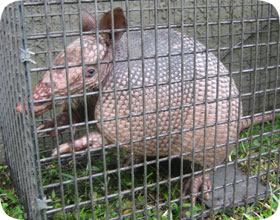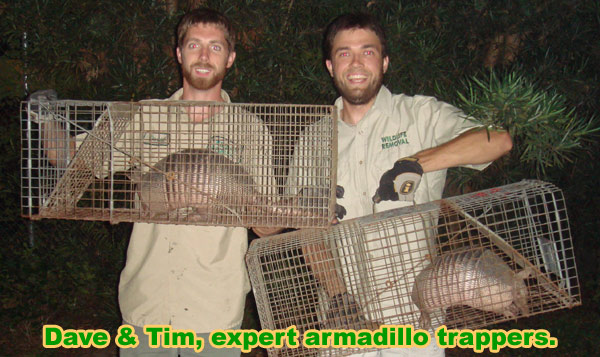- info@wildlife-removal.com
Call us for help in your town
Wildlife Removal Education
Armadillo Removal & Control
Need armadillo removal in your hometown? We service over 500 USA locations! Click here to hire us in your town and check prices - updated for year 2021.
 Armadillos are usually classified as a pest species due to their habit of digging and burrowing. The most common complaints include the following:
Armadillos are usually classified as a pest species due to their habit of digging and burrowing. The most common complaints include the following:
- Large tunnel under the house
- Small holes all over the lawn
- Landscaping/mulch is uprooted
- Burrowing is cracking concrete
- Burrowing is destroying pipes
- Presence is alarming dogs/pets
Need armadillo removal in your hometown? We service over 500 USA locations! Click here to hire us in your town and check prices - updated for year 2021.
How Do you Get Rid of Armadillos?
There's really only one way to go about it. You've got to catch the armadillos and relocate them off the property. There's no other good approach that I know of. Maybe having a
big, scary dog would help. But otherwise, this is a nocturnal animal that comes along into your yard or landscaping for just a short time every night or so, and digs a bunch of
holes while looking for earthworms and grubs. There is no effective repellent that'll keep them away, nor any device that will discourage them from entering the yard. A sturdy fence,
one that goes into the ground that they can't dig under would do as well. But if that's not an option, you just need to set some traps, catch them, and relocate them at least
five miles away. Of course, trapping is tricky for a novice, so read my how to trap an armadillo guide for
help, or the what to do if you find a nest of baby armadillos guide.

CAN'T I JUST USE A REPELLENT? Go ahead and try. In over half of the cases that I take on, the customer has already purchased all matter of magic "armadillo-b-gone"
or "armadillo-away" type repellents. These repellents are usually comprised of either napthalene (moth balls) or
predator urine (fox or coyote) or castor oil. I've personally observed dozens of cases in which customers
have loaded their yards with these sorts of gimmicks, or even poured entire boxes of mothballs or bleach down armadillo burrows (NOT good for the environment)
and it doesn't effect the armadillo's behavior one bit. The animal just
kicks the mothballs out of the way and continues to use the burrow. As usual
in wildlife control, there's no cheap and easy solution. If you are unable
to catch them yourself, your best bet is to call out a professional. You can read more about the topic on my armadillo repellent page or read Should You Handle Armadillos Yourself or Hire a Professional?.
You also have the option of trying to prevent the armadillos in the first place. I discuss some tactics on my how to keep armadillos away page, but
the reality is that it can be very difficult, and the only surefire thing that keeps them away is a sturdy fence around the perimeter of the property, one that extends underground, so they can't dig
underneath it. You also have some other options for how to keep armadillos out of the yard or garden, mostly through discouraging landscaping
such as gravel or heavy wood chips that they don't want to dig through.
HOW DO I REMOVE THEM MYSELF? There's a reason professional wildlife trapping companies exist. First of all, it's probably illegal for you to trap and remove
and relocate armadillos on your own in the state you live. As a non-indigenous species, it's often illegal to relocate armadillos. Most private citizens don't have the means to humanely euthanize trapped wildlife and
properly dispose of or cremate the carcass. Other regional laws regarding wildlife trapping may prevent you from self-trapping as well. Second of all, for those that lack experience, it's not very easy to trap armadillos.
One of the most common questions that I hear from annoying do-it-yourselfers all across the country is, "what kind of bait should I use to trap armadillos?". The answer is that there is no bait that will make an
armadillo enter a trap. Armadillos dig up worms and grubs from under the ground. They eat live insects. The will not eat any old food sitting on the surface of the ground. As usual, I've heard a bunch of old-wives
suggestions on bait: old cabbage, rotten bananas, a stocking full of earthworms, etc. Go ahead and try these: you might get a stray opossum, but you won't lure in an armadillo. The key to trapping armadillos in cage
traps lies in reading the subtle (and in some cases, not-so-subtle) clues that the animal leaves behind, and placing the traps just right - in the right areas, facing the right way, with the right stability, dirt padding
below, etc etc. Furthermore, a good wildlife trapper will use the animals behavior - its tendency to move along edges and bump along barriers in order to properly finish off the set and steer the armadillo in the trap -
the trap alone is not enough. A professional will also set several traps on the property if need be, to increase the odds. You can click on this map
of Professional Wildlife Removal Companies if you want to hire someone to help you.

ARMADILLO BEHAVIOR: It is the armadillos natural tendency to dig. They have powerful legs equipped with strong claws, and like most burrowing animals, can dig amazingly
quickly, often throwing mounds of dirt out behind them as they plow the earth. They dig for two primary reasons: first, they make burrows underground in which to live and raise young. They also often dig several shallow
(2-4 feet deep) holes in their range in which to escape should danger arise. The second reason for the digging is food. An armadillo's diet consists primarily of earthworms and beetle larvae (grubs) and sometimes other
insects. They have an amazing sense of smell, and root around on the surface, snuffling out food. When they detect it a few inches below the surface, they quickly dig and root their nose in the hole, and lick out the
invertebrate with their tongue. Armadillos are nocturnal animals, and do most of this foraging at night, although they will occasionally emerge and become active during daylight hours, often in cooler weather or after
a good rainstorm - when the worms come up. They usually sleep during the day, deep inside one of their burrows. They usually have a favorite burrow in which to den. Read About Armadillos.
ARMADILLO FACTS: Armadillos are unique animals for many reasons. The first noticeable thing about this animal is the "shell" - a collection of flexible bony plates
that cover all but the belly of the creature. The armadillos in North America are called Nine-Banded Armadillos, because they have a certain number of segments, or bands, of the bony shell across their back. The segments
give the animal some flexibility, maneuverability, and running ability. Yes, the armadillo can move along fairly quickly, in a hopping fashion, if need be. Armadillos will not bite people, or anything really. They have
teensy tiny mouths with small pegs for teeth. Most people seem interested in the fact that armadillos can carry the human form of leprosy. Armadillos inhabit an old branch of the evolutionary tree - the basic design is
unchanged in, I don't know, maybe 30 million years or something like that. These animals are often studied in fertility research due to another unusual trait: they always give birth to four identical twins: that's right,
the embryo splits into four before development. How curious! I don't think that female armadillos give birth every year, because I simply don't see many litters of young running around. I do see it from time to time,
but it's not like the sudden burst of newborns that accompany say, mother squirrels. The young dillos are born in March, and seem to take a year to fully mature. Once they reach full size, about 12 pounds, they stop
growing, unlike some other mammals.
ARE THEY BAD ANIMALS? No, not at all. Like all animals, they inhabit their own specific niche in the environment, and are well adapted to do what they do.
They are simple animals, and amongst the least intelligent of nuisance species that trappers deal with. They don't really provide much benefit to the ecology of the land, and in most cases in the US, are not native
to the area. However, they usually don't cause a whole lot of harm in the wild. The conflict usually occurs, as mentioned, due to their proclivity toward digging. Many people work very hard and spend a lot of money
on landscaping, and they simply do not want it destroyed. Furthermore, in the event that an armadillo burrows under some structure, be it a deck, sidewalk, AC unit, fuel tank, or the house foundation itself, the dillo
causes a threat to the integrity of the object - that is, with less dirt underneath the object, the object might collapse, or in the case of concrete walkways, crack. If an armadillo starts to dig under a vulnerable
object on the property, it might be a good idea to have the animal trapped and removed from the area. But you can catch them live and relocate them. You don't have to kill the armadillo.
More armadillo information:
What Diseases Do Armadillos Carry?
A Look At The Armadillo's Skin And Armor
How Did Armadillos Get Into North America?
The Armadillo's Diet
Are Armadillos Good Pets?
What is the Armadillo's Habitat?
Mating Habits of Armadillos
How Do Wildlife Rehabilitators Care For Armadillos?
How to Tell Whether You Have An Armadillo Under Your Shed Or Porch
Reasons Why Armadillos Dig
Armadillo Email From Reader: Hello, I have an armadillo living under my pool deck and it recently had babies. They are tearing up the yard something awful. I live in Titusville, Fl
and am wondering how much would you charge to remove them and what do you do with them once you catch them? I have heard that moth balls will make them leave on their own, is that true?
Email me back to let me know if you come as far as Titusville and if you do not come here what my best recourse for getting rid of these cool looking pests is for now. I
definitely do not
want them hurt but don't want to share my yard with them anymore. Thanks, Aletha
My Response: Moth balls definitely won't keep them away. Your best bet is humane trapping and relocation. I do not service Tutusville, but just check my directory in FL, and you can find a good wildlife operator there. Or you can read my guide to
How to Get Rid of Armadillos
Armadillo Email From Reader: Hello! I stumbled upon your web site due to my "critter" issues. I have a problem with armadillos and they have become a VERY large problem in the past few months digging up 3-5 decently
sized holes around and near our swimming pool area, alongside the wall that borders it (oh, and along with tearing up our lawn as well). We had a company, Terminex, come out here to spray like they normally do every few months
or so, and when we mentioned to them our "armadillo problem," they said they would trap them. But, after calling Terminex yesterday, they are now telling us that we have to go through a different company and it would cost
about $400!!!!!! $400 seems VERY steep as I worked with the FL Wildlife before and have trapped captive bred, loose or set-free Burmese and Reticulated Pythons ("Retics" being the "longest" snake in the world, not the Anaconda
which is also very large, but is heavier and has more "girth" than a Retic aka Reticulated Python; these snakes I captured were sometimes up to 20-25 feet! We NEVER charged anywhere close to the estimated $400 that we have been
given so far to remove the armadillos)... My question is this: I am in Brandon, FL about 10-15 minutes right outside of Tampa. I see that you are in Orlando. Can you recommend a good, honest and decently priced company that
will get rid of my family's armadillo problem for a reasonable price (and to get rid of these pests for good). I have called other "out of county" trappers and they also agree $400 is too steep. I was given the $400 estimate
by "Pest Tech," which I believe operates out the the greater Tampa Bay area and handles trapping, such as you do. Can you recommend anyone in Brandon or Tampa that will get the job done for a fair price and can "get the job done"
and remove these pesky armadillos? ANY information would be greatly appreciated! If you need ANY more info from me, please DO NOT HESITATE to e-mail me back. I am on the computer 24/7, as I am a Network Admin and Web Designer.
If you would like to speak over the phone, I can call if that suits you better... Thanks again and have a blessed day!
My Response: Sure! Just check my directory in FL and click on Tampa, and you can find a good wildlife operator there. His name is Mike, and he's the best in Tampa, bar none.


















